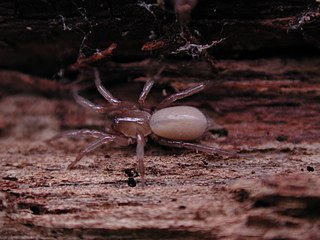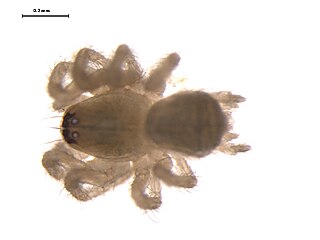
The recluse spiders, also known as brown spiders, fiddle-backs, violin spiders, and reapers, is a genus of spiders that was first described by R. T. Lowe in 1832. They are venomous spiders known for their bite, which sometimes produces a characteristic set of symptoms known as loxoscelism.

Leptonetidae is a family of small spiders adapted to live in dark and moist places such as caves. The family is relatively primitive having diverged around the Middle Jurassic period. They were first described by Eugène Simon in 1890.

Symphytognathidae is a family of spiders with 90 described species in eight genera. They occur in the tropics of Central and South America and the Australian region. Exceptions include Anapistula benoiti, Anapistula caecula, and Symphytognatha imbulunga, found in Africa, Anapistula ishikawai, found in Japan, and Anapistula jerai, found in Southeast Asia.
Theotima is a genus of small spiders in the family Ochyroceratidae.
Neoleptoneta is a genus of North American leptonetids that was first described by Paolo Marcello Brignoli in 1972.

Sphodros is a genus of North American purseweb spiders first described by Charles Athanase Walckenaer in 1835. It was considered a synonym of Atypus until 1980.

Mallos is a genus of cribellate araneomorph spiders in the family Dictynidae, and was first described by O. Pickard-Cambridge in 1902. Among the genus, Mallos gregalis is known to be a social spider species, living in groups and signaling each other by vibrating their web.

Coneweb spiders (Diguetidae) are six-eyed haplogyne spiders that live in tangled space webs, fashioning a cone-like central retreat where they hide and lay eggs. It is a small family, containing only two genera split between a range in the Southwestern United States and Mexico and a range in South America. Members of the genus Diguetia usually build their webs in shrubs or between cactus pads. They have the same eye arrangement as the venomous recluse spiders, but none are known to be harmful to humans.

Nesticus is a genus of American and Eurasian scaffold web spiders first described by Tamerlan Thorell in 1869.

Cicurina, also called the cave meshweaver, is a genus of dwarf sheet spiders that was first described by Anton Menge in 1871. Originally placed with the funnel weavers, it was moved to the Dictynidae in 1967, then to the Hahniidae in 2017. The name is from the Latin root "cucur-", meaning "to tame".

Bassaniana, commonly called bark crab spiders, is a widespread genus of crab spiders that was first described by Embrik Strand in 1928.

Filistatinella is a genus of North American crevice weavers that was first described by Willis J. Gertsch & Wilton Ivie in 1936. They are 1.5 to 3.5 millimetres long, and have a dark brown abdomen, longer than wide, with a few gray scales.

Neoantistea is a genus of dwarf sheet spiders that was first described by Willis J. Gertsch in 1934.
Chisoneta is a genus of North American Leptonetids that was first described by J. Ledford in 2011.
Titanebo is a genus of North American running crab spiders that was first described by Carl Eduard Adolph Gerstaecker in 1933.
Anopsicus is a genus of cellar spiders that was first described by Ralph Vary Chamberlin & Vaine Wilton Ivie in 1938.
Metagonia is a genus of cellar spiders that was first described by Eugène Louis Simon in 1893.
Modisimus is a genus of cellar spiders that was first described by Eugène Louis Simon in 1893.
Pholcophora is a genus of cellar spiders that was first described by Nathan Banks in 1896.
Jalapyphantes is a genus of dwarf spiders that was first described by Carl Eduard Adolph Gerstaecker & L. I. Davis in 1946.










